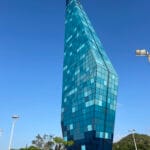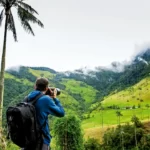
The Tayrona: destination of nature and adventure
The park offers to its visitors bays, beaches, mangroves, coral reefs and are complemented by a jungle landscape
Blue and green crystalline waters, a unique ecology and biodiversity in the world and a possibility of accommodation that allows direct contact with nature, are some of the characteristics that make the Tayrona National Park the ideal destination for nature lovers and the adventure.
This beautiful natural reserve chosen by NatGeo Traveler as one of the 20 destinations to visit in 2012, is located between the Atlantic Ocean and the Sierra Nevada de Santa Marta and is made up of 15,000 colorful acres of which 3,000 are of marine area, Habitat of thousands of colorful species that are distributed in different thermal floors that go from the level of the sea to heights of 5.775 meters.
There are also 108 species of mammals, including the howler monkey, the tiger, the monkey, the deer and more than 70 species of bats. Likewise, the park has about 300 varieties of birds among which are the white eagle and the solitary eagle. In its oceans live 110 species of corals, 471 of crustaceans and 700 species of mollusks, among others.
Towards the center of the park are the archaeological ruins of Pueblito, a magical place that holds the secrets of the ancestors of the Tayrona civilization that occupied the region from pre-Columbian times to colonization.
The Tayronas were an environmentalist culture that made mountain water pipes to bring this source of life to their homes in an organized way. This civilization designed its cities and terraces of culture always thinking about protecting the nature and the visitors of the park have access to the ruins and can attest to its creative capacity.
Another of the great attractions of the park is the sector of Cañaveral and Arrecifes, of admirable beauty, where the Ecohabs were arranged, a luxury accommodation in bohíos built in imitation of the Kogui. They are styles of malokas or circular plants with wooden structures and thatched roofs where tourists can rest, enjoy unique sunsets and sleep lulled by the bursting of waves against the beach.
The Cabo de San Juan de Guía, a ninety-minute walk from the entrance of the park, is a scenario of explosion and contradiction where the force of the sea and the exciting rainforest collide with each other to create an environment that stimulates the senses. A pre-columbian stone path surrounded by thick vegetation links this unique place with Chairama, another of the park’s attractive places.
On the west side of this enchanted place is Quebrada Valencia, a river that, on its way to its expected ocean, passes through a huge stone wall forming monumental waterfalls, white and effervescent foams that seem to organize a spectacle for the delight of each Tourist that arrives there.
HOW TO GET TO
It can be entered by two sectors:
- El Zaíno, through which one enters Cañaveral, is 34 kilometers from Santa Marta, by the Caribbean Troncal that goes to Riohacha.
- Zalangana, where you enter the area of Neguanje, 10 kilometers from Santa Marta, (17 km from El Rodadero).
The ticket is worth 12,000 COP for national tourists, 6,000 COP for students and 30,000 COP for foreigners .
WHERE TO STAY
In the areas of Arrecife and Cañaveral there are camping areas and Ecohabs are available (cabins with capacity for 4 to 6 people whose characteristics are similar to the constructions of the houses of the ancient Tayrona culture).
-
Note taken and translated from the website of Colombia Travel
-
Clic aquí para versión en Español








